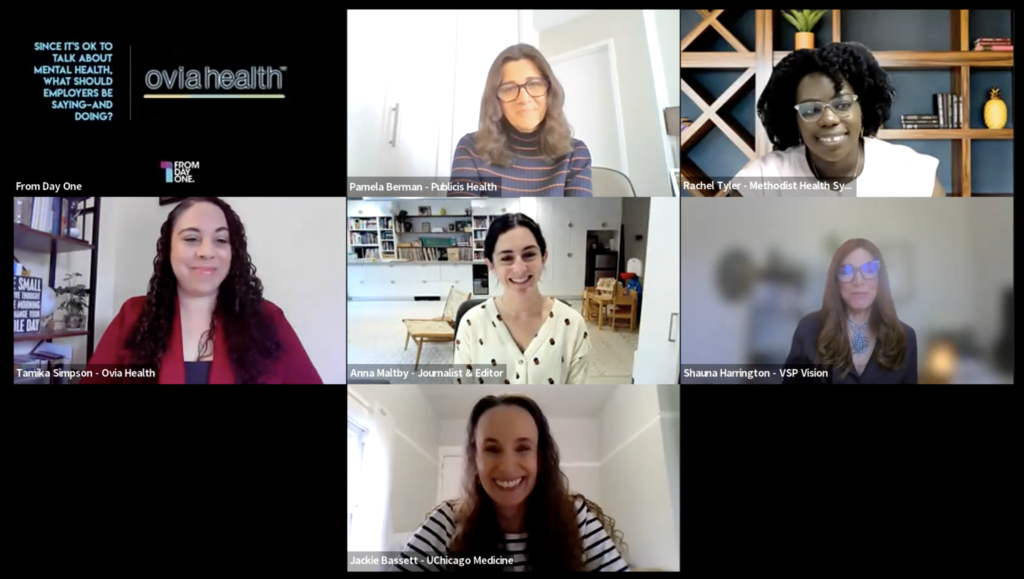Since It's OK to Talk About Mental Health, What Should Employers Say—and Do?


The Covid-19 pandemic was not just an assault on physical health. It helped trigger a cascade of mental health challenges, as well. According to the World Health Organization, in the first year of the pandemic alone, rates of anxiety and depression increased by 25% worldwide.
Yet at the same time, perhaps because of the ubiquity of suffering, the stigma around mental illness is beginning to dissipate. Nearly 90% of Americans in a poll said they believe having a mental health disorder is nothing to be ashamed of, according to a survey from the American Psychological Association. So with more strain on mental health, and people feeling more open about broaching the subject, how can employers best support their team?
Experts discussed this question and more in a From Day One webinar titled, “Since It’s OK to Talk About Mental Health, What Should Employers Be Saying—and Doing?,” for which I served as moderator. On the panel were Jackie Bassett, director of people strategy at UChicago Medicine; Shauna Harrington, senior director of outreach and executive talent at VSP Vision; Tamika Simpson, care advocate lead at Ovia Health; Rachel Tyler, HR business partner at Houston Methodist; and Pamela Berman, chief talent officer for North America at Publicis Health.
What Has Changed?
A cultural shift began to occur even before the pandemic, with many employees becoming much more open about discussing mental health, Berman said. “It wasn’t that long ago that employers and employees just never talked about mental health or mental wellness. In the last two and a half years, younger employees maybe just coming out of school were much freer about, say, whether or not they’re seeing a therapist–much more liberal at talking about it.” And with the added stressors of the pandemic, mental health quickly became a topic employers couldn’t afford to sweep under the rug.
For one thing, the experts explained that the epic surge in workers leaving their jobs for better work situations has contributed to widespread understaffing, requiring many employees to essentially take on multiple jobs. For another, added stressors at home–particularly the precarious nature of child care in a pandemic, Simpson noted–have made it difficult to be fully present at work, and have led many working parents and caregivers to worry about their performance and growth opportunities.

In the health care industry, workers are under added stress because of the widely reported pandemic-related strains on the system, among other factors, Tyler and Bassett noted. And finally, while the option to work remotely has come as a welcome source of both Covid safety and flexibility for those who have it, sitting in front of a computer at home all day can be stressful for both the mind and the body, Harrington said.
Unfortunately, employers aren’t always innocent here: Expecting full productivity during difficult times, ignoring the realities of pandemic life, and not moving quickly enough to provide employees with the resources they need to reach their goals–all these lapses can contribute to stress and burnout, the experts said.
How Should Employers Respond?
Thankfully, many smart policies, benefits, and other resources can help companies support their teams’ mental health, respond appropriately when mental health concerns arise, and ease some of the most common stressors that affect employees. It’s not just the humane thing to do, the experts said–it’s a strong investment in the health of the organization. Bassett cited a recent University of Chicago study that found for every dollar an employer spends on mental health treatment, the company sees an average return on investment of $4.
The experts shared a wealth of ideas, including:
In some cases, a combination of time-off and stress-relief policies come together as a comprehensive solution. At Ovia, the company offers unlimited paid time off for employees, as well as mental-health days, said Simpson. “Another thing that I really enjoy personally is no-meeting Wednesdays. It’s pretty simple. It’s a very easily enforced policy, but it allows for that heads-down time, really focusing, not having your day broken up by meeting after meeting. Just little things like that can really make a huge impact in the mental health of the employee,” she said.
Finally, the experts agreed that equipping managers with information and training on how to appropriately discuss mental health and self-care with their employees—and what benefits are available to them—is critical. It’s a balance: “We have to partner with our leaders and managers to help them recognize signs of burnout and check in with their team,” Tyler said, “but we’re not expecting them to pull a theoretical couch into their office” and attempt to take on the role of a mental health professional. The key, the experts said, is to keep things professional while still tapping into empathy, normalizing self-care, and encouraging folks to take advantage of the benefits and policies available.
Anna Maltby is an editor, content strategist, and exercise specialist. She has served as executive editor of Elemental, the health and well-being publication on Medium, as well as deputy editor of Real Simple and Refinery29.
The From Day One Newsletter is a monthly roundup of articles, features, and editorials on innovative ways for companies to forge stronger relationships with their employees, customers, and communities.